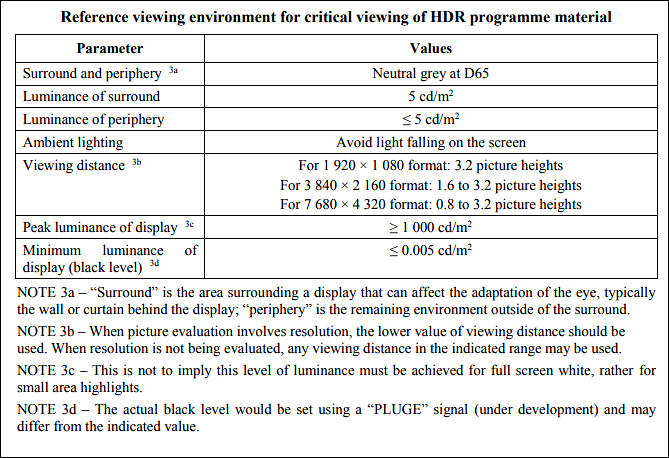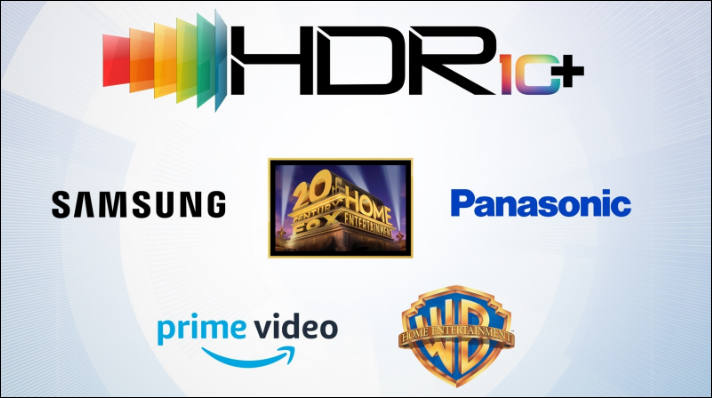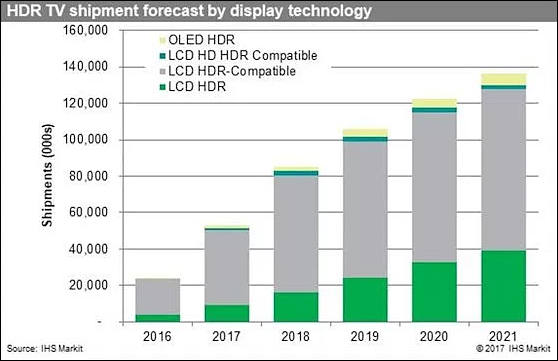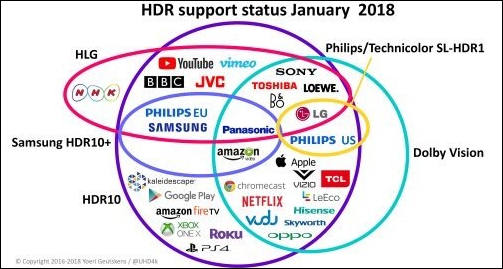
It allows to keep PV going, with more focus towards AI, but keeping be one of the few truly independent places.
-
2016 is a year of HDR, as 2014 had been for basic 4K and 2015 had been for color gamut and quantum dots.
Current REC.709 televisions only display 33% of the actual amount of colours you can see and they are also limited to around 100 NITS of brightness (NITS are the unit used to measure brightness),
And this is that happens if you read too much marketing literature.
In reality most consumer TVs are not 100nits (and at retail demo rooms they are even more far from it). And they are NOT limited here.
Next thing people do not understand that sRGB color gamut is not so limiting due to fact that we see reflected light in nature and super saturated colors that is not included can be rarely seen in nature.
Next trap lies in complete misunderstanding on that dynamic range of reproduction device is (and replacing it in the head with dynamic range of camera).
Dolby lie comes from marketing proposal that limiting factor of consumer sets comes from maximum brightness, and it is just not true. While actual limiting factor now come from black level on LCD sets. And all modern quantum dots and so called "UltraHD Premium" marketing labels have nothing to do with it.Real cure can come from OLED side, where black level is limited only by room reflected light. OLED also can be made with very wide gamut with ease. Main issue with them is... color degradation and burn in, especially with long time high brightness.
In reality that Dolby want to do now is to introduce premium theaters where they will check reference brightness level and try to keep it at acceptable level (saving on bulbs in theaters is very common business, as with brightness reduction very expensive bulbs work much longer) and also check quality of projectors and used screens to do not have washed out colors.
-
Next step in stupid marketing ideas - Samsung's HDR10+ Adaptive
Your Samsung TV will use its light sensor to show movies the way the director really intended, even if it has to make some adjustments.
“Upcoming QLED products” from Samsung — that we would expect include its 2021 lineup of 4K TVs — will support HDR10+ Adaptive, so that in Filmmaker Mode it will use the TV’s light sensor to adjust for room conditions.
-
YouTube is adding the ability to broadcast live streams in High Dynamic Range (HDR), enabling a better quality of live video. The platform says that anyone with existing hardware that supports the standard can start streaming HDRified footage right away.
Need longer mumbling videos, but now in HDR. Nice.
-
Universal Pictures Home Entertainment (UPHE) in association with Samsung announced Thursday that it will introduce both new release and catalog movies and videos for the home mastered in the HDR10+ High Dynamic Range (HDR) profile that is based on dynamic metadata.
-
Nice video about HDR
-
Small leak from talk
HDR coverage and advertising in media is presently mostly sponsored by Samsung and some Japanese manufacturers. HDR complain already paid off as LG OLED plans had been pushed further and management is afraid to increase manufacturing with previous pace. Main idea of HDR is to hit weak spot of OLED - maximum brightness and ability to retain such brightness for long without consequences. In case of LCD it is very simple and cheap to just make full array led backlight and make any brightness you want. With OLED it is no simple solution. So actual fight is for your money, where HDR is used as tool to punish competitor with highest image quality product.
-
DR10+ Technologies, LLC, a joint venture among 20th Century Fox, Panasonic Corporation and Samsung Electronics today announced the first certified products and first adopters for the HDR10+ license program. Panasonic and Samsung are also among the first to announce firmware has been deployed to select 2018 television models enabling support of HDR10+ for consumers.
HDR10+ advances the current industry standard of High Dynamic Range (HDR) and HDR10 TV formats. As an upgraded version of HDR10, HDR10+ adds dynamic metadata to each frame. This optimal HDR data enables advanced chipsets from leading manufacturers to create a true-to-life picture across a wider range of displays.
-
HDR Gaming Interest Group (HGIG)
Draft HDR Game Content Production and Distribution Guidelines will help optimize the consumer gaming experience when playing game content in high dynamic range (HDR).
- Activision Publishing, Inc.
- ASUSTek Computer Inc.
- CAPCOM Co., Ltd.
- EIZO Corporation
- Electronic Arts
- Epic Games
- HP Inc.
- Koninklijke Philips N.V.
- LG Electronics, Inc.
- Microsoft Corporation
- Panasonic Corporation
- Samsung Electronics Co., Ltd.
- Sony Interactive Entertainment
- Sony Visual Products
- Square Enix Co., LTD.
- Toshiba Visual Solutions Corporation
- Ubisoft
- Unity Technologies
- Vicarious Visions
- VIZIO, Inc.
- WB Games
-
10,000 nits isn’t anything to be afraid of. We should embrace it and raises the question, `Is 10,000 nits enough?’
“I think SMPTE should start looking at ST.2084 and making the peak brightness limits go higher,” Pruitt said. “This is supposed to be an aspirational spec, like ST.2020, that people can working on and prepare for the next 10 years. But [the technology] is coming faster and faster than I think anyone expected.”
https://hdguru.com/calibration-expert-is-10000-nits-of-brightness-enough/
Problem with managers and such is that they do not look how tech is made.
It is not problem with 10000nits except that manufacturer profits will shrink.
-
Samsung still pushing HDR10+
Mandel said HDR10+ tools are ready for mastering on a system like Resolve or Color Front for post-production. There is a very straight forward path to upgrading HDR10 content so that anyone who already has produced content in the HDR10 profile can fairly painlessly upgrade to HDR10+, Mandel said.
https://hdguru.com/hdr10-looks-for-greater-availability-in-content-hardware/
-
Start of HDR10+ licensing
Los Angeles, CA – June 20, 2018 – HDR10+ Technologies, LLC today announced the start of the new licensing and logo certification program for HDR10+ technology. HDR10+ is the royalty-free, open standard dynamic metadata platform for High Dynamic Range (HDR), which optimizes picture quality for 4K Ultra HD displays and improves the viewing experience for all audiences.
The new HDR10+ technology optimizes picture quality for 4K Ultra HD displays by using dynamic tone mapping to reflect frame to frame or scene to scene variations in brightness, color saturation, and contrast.
The resulting enhanced viewing experience can now be easily provided on a wide range of displays bringing the viewing experience much closer to the original creative intent for the content.
The HDR10+ license and logo certification is available to interested companies that meet HDR10+ technical and testing specifications. The HDR10+ certification program qualifies the compliance based on different device categories and their technical performance to ensure that HDR10+ compliant products meet high standards for picture quality.
Consumers will be able to look for the HDR10+ logo which signifies a product’s certification. The royalty-free adoption of HDR10+ for content production, distribution and consumption has already gained momentum with over 40 supporting companies.
-
Viewing limits are tight

https://www.itu.int/dms_pubrec/itu-r/rec/bt/R-REC-BT.2100-1-201706-I!!PDF-E.pdf

 sa2962.jpg669 x 458 - 107K
sa2962.jpg669 x 458 - 107K -
The criteria for Ultra HD Premium certification was developed using consumer focus groups. They actually tested on viewers the differentials between various settings, so that, for example, `if the brightness went from from 800 to 900 nits, was it noticeable?, 900 to 1,000 nits, was it noticeable? 1,000 to 1,100?, 1,200? No?’
So 1,000 was what they came up with for LED-LCD. For OLED it was 540 nits. Could it have been higher? Sure. But 1,000 and 540 nits was something they felt was representative of what consumers typically could see relative to the physical improvement in picture quality.
It is so damn lie.
As numbers they have actually come from engineers of leading brands. Because for LCD backlight cost rise around $10-20 after 1000nits, and OLED just can't produce anything above 540nits for any prolonged periods without burn in.
Btw note here that actually difference between absolute top 5000nit model and 400nit cheap one is usually only in two cheap things - more dense and more powerful backlight leds (around $30-70 difference) and more advanced $5 backlight controller that manages all this stuff.
-
And yet another one - Technicolor HDR
HDR platform was being championed by Technicolor and Royal Philips NV for selection as a candidate standard to be part of the complete standard for the next-generation ATSC 3.0 over-the-air broadcasting system.
Technicolor HDR is the common name of the joint HDR format that merges together elements of separate proposals developed by Philips and Technicolor. Proponents of the combined system, which is also known as SL-HDR1, have been doing most of their proselytizing to TV broadcasters, pay-TV service providers and Hollywood studios.
But that’s not because the format is any less “dynamic” on TV screens than either the Dolby Vision or HDR10+ platforms it is competing against. All three HDR profiles use dynamic metadata which allows color grading on a scene-by-scene or shot-by-shot basis, for more realistic overall look than is seen in standard dynamic range (SDR) or even the static metadata HDR10 HDR profile.
Technicolor HDR is also a format supported in select 2017 and 2018 LG 4K OLED TVs and Super UHD LED-LCD TVs, and will be added to select Philips-branded 4K Ultra HDTVs in North America in 2019.
Yes, it is all much worse than Betacam vs VHS
-
Chrome 64 adds support for HDR content if you’re using Chrome on a PC running the Windows 10 Fall Creators Update. You’ll also need discrete graphics and an HDR-compatible display.
-
Warner Bros. is joining Samsung, Fox and Panasonic in supporting HDR10+ on its 4K video releases


 sa1268.jpg712 x 398 - 39K
sa1268.jpg712 x 398 - 39K -
Sony will begin to deliver in mid-to-late January its promised firmware update bringing support for Dolby Vision high dynamic range (HDR) to select Bravia 4K Ultra HD A1E OLED TVs and 4K LED-LCD TVs with full-array LED backlighting and local dimming.
New firmware with Dolby Vision support will arrive in the United States and Canada in the Sony A1E series of 4K OLED TV models, as well as in the Z9D, X940E, and X930E series of full-array LED-LCD TVs sold in the United States and Canada.
-
Netflix HDR start under Windows 10
We are thrilled to announce the addition of High Dynamic Range (HDR) support on Windows 10 for both the Edge browser and the Netflix app. With this update, Netflix members who have a supported device and a premium plan can enjoy amazing Netflix movies and shows in HDR. With HDR enabled, fans can immerse themselves in the delicious colors of Chef’s Table, the terrifying depths of the Upside Down in Stranger Things 2, and enjoy the upcoming Netflix film Bright starring Will Smith. And this is just the beginning! Today, we have over 200 hours of HDR entertainment, and in 2018 even more HDR PCs will enter the market and support the growing number of Netflix originals.
https://medium.com/netflix-techblog/netflix-now-supports-hdr-on-windows-10-1928b40ac7d
-
So, HDR10+
Samsung Electronics and Amazon Prime Video today announced the entire Prime Video HDR library is now available in HDR10+, a new open standard that leverages dynamic metadata to produce enhanced contrast and colors on an expanded range of televisions. The Prime Video HDR10+ catalogue includes hundreds of hours of content such as Prime Originals The Grand Tour, The Marvelous Mrs. Maisel, Jean-Claude Van Johnson, The Tick and The Man in the High Castle plus hundreds of licensed titles. Prime Video is the first streaming service provider to deliver HDR10+ content to its users. HDR10+ is available on the entire Samsung 2017 UHD TV lineup – including the premium QLED TV models.
The HDR10+ technology on Prime Video incorporates dynamic metadata that allows high dynamic range (HDR) TVs to adjust brightness levels on a scene-by-scene or even frame-by-frame basis. By applying individualized tone mapping to each scene, HDR10+ delivers an incredible viewing experience for next generation Samsung displays. The picture quality offers an enhanced visual experience with more detailed expressions, brighter shadow areas and more accurate color renderings that stay true to the creator’s original intent. Through the utilization of the precise “Bezier” based tone-mapping guides, Amazon is able to deliver the optimal viewing experience across a variety of TV models.
-
Nice. Any changes planned for 2018?
-
Static HDR (including HDR10) will go out of fashion next year with HDMI 2.1
Next step (that must be actually start one!) will be HDR information being specific to one HEVC / H.264 encoded block.
-
There’s one other wrinkle. Consumer HDR displays have legally mandated (regulated by the California Energy Commission and by similar European agencies) limits on the maximum power that televisions can use in relation to their size and resolution. Consequently, automatic brightness limiting (ABL) circuits are a common solution manufacturers use to limit power consumption to acceptable and safe levels for home use. Practically speaking, an ABL circuit limits the percentage of the picture that may reach peak luminance without automatically dimming the display. This type of ABL limiting is not required on professional displays, but some manner of limiting may still be used to protect the display from damage stemming from drawing more current than they can handle in exceptionally bright scenes.
-
Situation on market and predictions

Global unit shipments of televisions supporting High Dynamic Range (HDR) are forecasted to reach 12.2 million in 2017 and will continue to expand to a 47.9 million in 2021, according to forecasts of television marketing activity conducted by IHS Markit TV Design and Features Tracker for the third quarter of 2017.

 sa403.jpg558 x 361 - 31K
sa403.jpg558 x 361 - 31K
Howdy, Stranger!
It looks like you're new here. If you want to get involved, click one of these buttons!
Categories
- Topics List23,990
- Blog5,725
- General and News1,353
- Hacks and Patches1,153
- ↳ Top Settings33
- ↳ Beginners256
- ↳ Archives402
- ↳ Hacks News and Development56
- Cameras2,366
- ↳ Panasonic995
- ↳ Canon118
- ↳ Sony156
- ↳ Nikon96
- ↳ Pentax and Samsung70
- ↳ Olympus and Fujifilm100
- ↳ Compacts and Camcorders300
- ↳ Smartphones for video97
- ↳ Pro Video Cameras191
- ↳ BlackMagic and other raw cameras116
- Skill1,960
- ↳ Business and distribution66
- ↳ Preparation, scripts and legal38
- ↳ Art149
- ↳ Import, Convert, Exporting291
- ↳ Editors191
- ↳ Effects and stunts115
- ↳ Color grading197
- ↳ Sound and Music280
- ↳ Lighting96
- ↳ Software and storage tips266
- Gear5,420
- ↳ Filters, Adapters, Matte boxes344
- ↳ Lenses1,582
- ↳ Follow focus and gears93
- ↳ Sound499
- ↳ Lighting gear314
- ↳ Camera movement230
- ↳ Gimbals and copters302
- ↳ Rigs and related stuff273
- ↳ Power solutions83
- ↳ Monitors and viewfinders340
- ↳ Tripods and fluid heads139
- ↳ Storage286
- ↳ Computers and studio gear560
- ↳ VR and 3D248
- Showcase1,859
- Marketplace2,834
- Offtopic1,320







